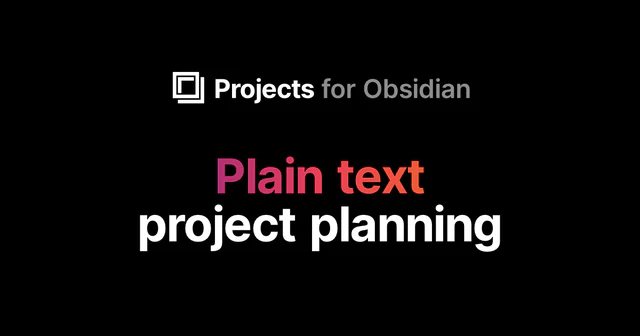How I set and track goals using Obsidian and OKRs
For as long as I can remember, I’ve been setting and documenting goals for myself. Usually though, I’d eventually lose them to Google Drive or some trendy productivity app. Some were paid. Most had some obscure proprietary format. Once it was time to plan the next quarter, either I’d forgotten how to use the app, or my subscription had expired. My high-level goals would inevitably become disconnected from my low-level tasks since they relied on me constantly having to configure and sync between all the apps and formats.
While I started using Obsidian as a simple note-taking application, it has now become an essential part of how I write, think, and learn. There are three main reasons why I believe Obsidian is an excellent tool for setting and tracking goals:
All your data is stored in Markdown documents—pure text files. You’d be able to use them even if you decided to move on from using Obsidian.
You can build automated workflows for tedious tasks through many of the community-built plugins for Obsidian.
I’m already using Obsidian daily for all my writing and note-taking. My goals are only a keyboard shortcut away.
In this article, I’ll walk you through how I plan and track my professional and personal goals in Obsidian.
Thank you to Ursula Kallio for inspiring me to reexamine the workflow and complete the missing pieces!
OKR—Objectives and Key Results
I’ve been using the popular OKR goal-setting framework even before I switched to Obsidian. Since I’m already using it at work, I decided to use it as a base for my goal-setting workflow.
In short, OKR stands for Objectives and Key Results.
- Objectives are statements of what you want to accomplish. They should be simple, straightforward, and make you excited.
- Key Results are metrics that tell you whether you’ve accomplished your Objective.
For example, a good OKR, as suggested by John Doerr, would have the following structure:
I will {objective} as measured by {key results}.
I won’t dive much deeper into OKRs and how to use them. Feel free to consult your favorite search engine to learn more.
While the workflow is heavily inspired by the OKR methodology, you can easily adapt it to other goal-setting methodologies.
Workflow
I plan and track my goals over three time periods: quarterly, weekly, and daily. I then break down and define goals for each of those time periods:
- Quarterly goals -> OKR
- Weekly goals -> Initiatives
- Daily goals -> Tasks
I use the Periodic Notes and Calendar plugins to create notes from templates for each time period. Each periodic note embeds the higher level goals: The weekly note embeds the OKRs for the current quarter, and the daily note embeds the initiatives for the current week. This way, I can trace my goals every step of the way.
While not required, I also use the QuickAdd plugin to create OKRs more conveniently.
Let’s look at each part of the workflow from top to bottom!
The OKR index
The OKR index note is where I outline my goals for the coming quarter.
Each quarter is a second-level heading, broken down into three life categories: Personal, Relationships, and Professional. I’ll come back to why I’ve chosen to group my goals this way.
For now, here’s an example of what my index note would look like:
OKRs.md:
# OKRs
## 2021 Q4
**Start:** 2021-11-01
**End:** 2022-01-31
### Personal
- [[2021-Q4 Improve my cooking skills]]
### Relationships
- [[2021-Q4 Hang out with friends]]
### Professional
- [[2021-Q4 Become a better writer]]
## 2021 Q3
...Every quarter
When a new quarter is about to start, I create a new OKR from a template using the QuickAdd plugin and begin drafting the key results. Finally, I add a link to the objective from the index note under the appropriate category.
The OKR note defines my goal and how I will know I’ve accomplished it. If you’re not a fan of the OKR structure, feel free to define your goal in any way that makes sense to you.
While it’s not really necessary for this workflow, I like to connect each objective to one or more of my core values. It helps me build up excitement for the objective if I know what core values I satisfy by accomplishing it.
Templates/OKR.md:
---
tags: [okr]
---
# {{NAME}}
**Core values:**
**Key results:**
-Here’s an example of what an OKR could look like:
OKRs/2021-Q4 Improve my cooking skills.md:
---
tags: [okr]
---
# Improve my cooking skills
**Core values:** [[Creativity (value)]], [[Quality (value)]], [[Beauty (value)]]
**Key results:**
- Take a cooking class
- Cook ==3== new recipesEvery week
At the start of every week, I use the Calendar plugin to create a weekly note from my weekly template. I use the weekly note to plan the coming week and to review it afterward.
I plan the week by creating initiatives based on the OKRs for this quarter. Initiatives are tasks that bring me closer to accomplishing my objective.
I embed the objectives for the current quarter from the index note to remind myself of my OKRs every week. You can embed another note by adding an exclamation mark at the start of an internal link, ![[like this]].
Templates/Weekly.md:
# 🗓️ {{date:gggg-[W]ww}}
## Objectives
![[OKRs#2021 Q4]]
## Initiatives
- [ ]
## Review
**What went well this week?**
- **What's my biggest challenge right now, and what help do I need?**
-One benefit of keeping the OKRs in their own notes is that I can hover over the embedded objectives in my weekly note to preview the key results for that objective without opening the OKR note. This helps determine what initiatives I want to pursue for the week.
Every day
Starting the day, I open the Daily note and plan what I’ll do for the day. My daily note also serves as my Inbox for the day. My thoughts or book recommendations during the day go into my daily note.
At the top of the daily note, I embed the initiatives from my weekly note. This way, I’m reminded daily of what I want to accomplish during the week. Embedding notes this way gives me full traceability from my quarterly goals to my daily tasks.
Templates/Daily.md:
# 🗓️ {{date:dddd, MMMM Do}}
![[{{date:gggg-[W]ww}}#Initiatives]]
## Tasks
- [ ] Inbox zero
## Scheduled
-
## Notes
-Finding motivation
Every now and then, I—and I’m sure you do too—go through periods where motivation and inspiration are hard to come by. When you’re struggling to just get through the day, the last thing you need is to feel even worse for not keeping up with your goals.
Instead of beating myself up when it happens, I try to create forgiving systems in my life. Systems that make it easy to get back into again. Whatever tool, system, or process I use, it has to be resilient to these low periods in my life. When I eventually find my way back, picking up again has to be trivial. If I need to relearn or reconfigure an app before I’m caught up, it’s likely not going to happen.
Some days, I just don’t feel like being productive. I might skip the weekly planning because I had a rough weekend. The beauty of this workflow is that I can pick it up again next week. Didn’t get to writing your daily note today? Try again tomorrow.
Here’s my track record for last month. As you can see, I skipped several weekly and daily notes.

By focusing on making it easy to pick up the ball whenever I drop it, I can return to it whenever I find the motivation again.
Using OKRs for my personal life
In the past, I’ve only tracked my professional goals, which unfortunately meant that my personal goals often ended up in the backseat. Since professional goals were the only ones I tracked, they received more attention than they deserved.
My first reaction when I started creating OKRs for my personal life was, “Wow, this is a lot of commitments!”. No wonder I wasn’t making any progress on many of them. In the end, I’m the same person at all hours of the day. By setting and tracking personal goals along with my professional ones, I’m more intentional (and realistic) about my mental capacity.
In practice, I define 2–3 objectives per life category, totaling 8–9 per quarter.
I’ll admit I’m no expert at writing OKRs—heck, not even half decent—but I find it still works for me. Most of my personal OKRs have activity-based key results: they measure the things I do rather than the value they provide. Mainly because my personal goals can vary dramatically from quarter to quarter, so I don’t bother defining proper KPIs for them.
In other words, I’m sacrificing the quality of my personal OKRs to consolidate my goals into one single framework. Because anything worth doing is worth doing poorly.
Improving the workflow
I currently have no way of updating progress for the key results in my OKRs. I’d love a plugin that turns a Markdown task into a progress bar.
In the following example, 1234 is the current value that I can update throughout the quarter:
- [1000,1234,2000] Reach ==2000== followers on TwitterFinal thoughts
By using Obsidian for goal-setting, I bring it into an existing system that I’m already using every day.
I believe three (technically four) main features enable this workflow:
- Plugins like Periodic Notes and Calendar lets you automate note creation based on time.
- Linking notes lets you drill down through my periodic notes with full traceability.
- Embedding notes lets you see the bigger picture even when I’m not actively working on it.
I want to stress that I’ve arrived at this workflow by starting small and making incremental changes. I’ve covered the steps in the workflow from high-level to low-level. If you’re new to Obsidian or goal tracking in general, start with the low-level parts of the workflow, such as setting up a daily note. Once you’ve turned it into a habit, try adding a weekly note, and so on.
I’d love to hear your suggestions on what can be improved!


